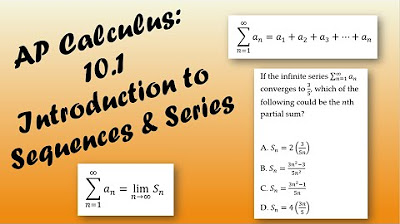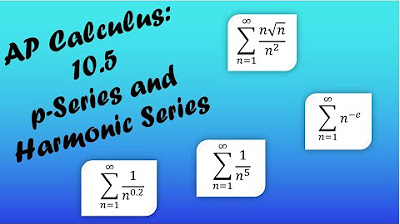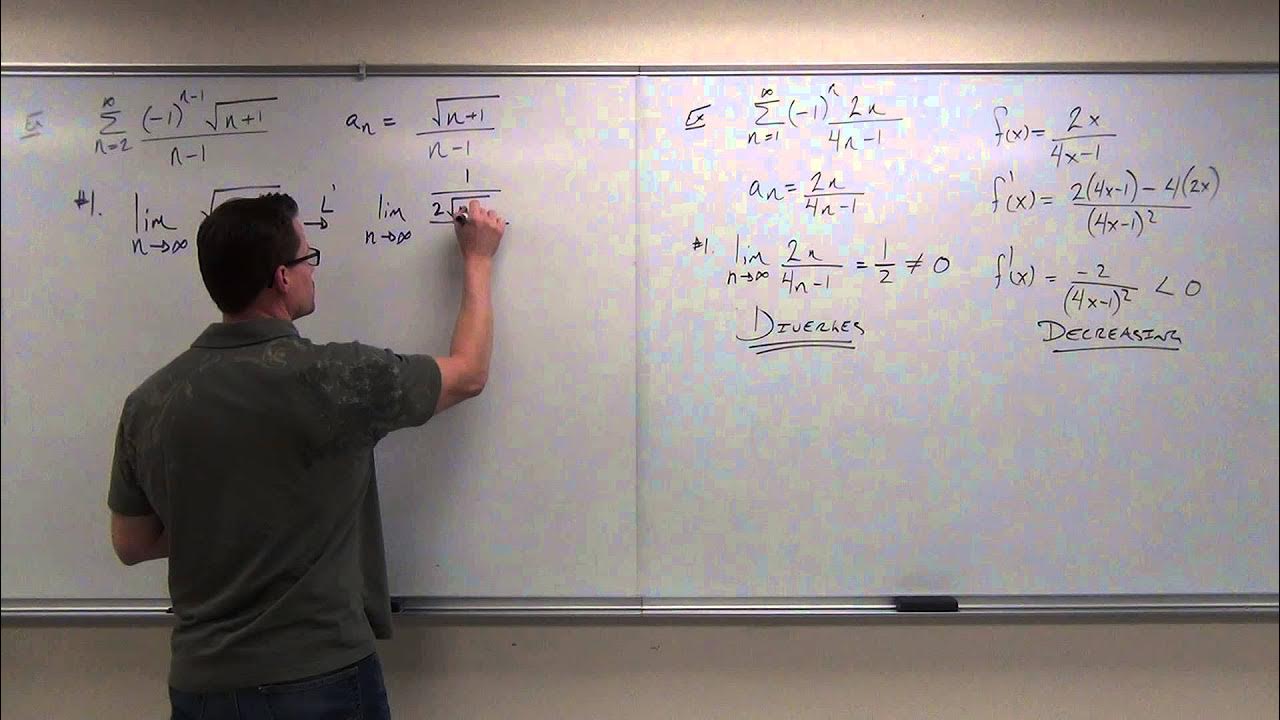700 years of secrets of the Sum of Sums (paradoxical harmonic series)
TLDRThis Mathologer video delves into the paradoxical properties of the harmonic series, exploring its infinite nature and slow divergence. It presents thought-provoking experiments, such as the balancing act and the leaning tower of blocks, to illustrate mathematical concepts. The video also discusses the historical proof by Nicole Oresme and introduces the Euler-Mascheroni constant, gamma, in approximating the partial sums of the series. Additionally, it touches on the intriguing fact that every positive number can be represented as a sum of sub-series within the harmonic series.
Takeaways
- 📚 The harmonic series is an iconic infinite series in mathematics with many paradoxical properties that have been studied for centuries.
- ⚖️ A thought experiment involving a balance with weights can demonstrate the principle of leverage and the center of mass, related to the harmonic series.
- 🏗️ The 'Leaning Tower of Lire' puzzle involves stacking blocks to create the maximum overhang, which is connected to the harmonic series and its sum.
- 💡 The harmonic series diverges to infinity, a fact that can be proven in various ways, including a 700-year-old proof by Nicole Oresme.
- 📈 The partial sums of the harmonic series are never integers, except for the first term, and approach infinity very slowly.
- 🌟 The Euler-Mascheroni constant, γ, plays a crucial role in approximating the partial sums of the harmonic series, improving the accuracy as n increases.
- 🔢 The sum of the harmonic series contains many important infinite series, such as geometric series and series related to the Riemann zeta function.
- 🤔 Every positive number can be represented as the sum of infinitely many sub-series of the harmonic series, using a greedy algorithm approach.
- 🐢 Some sub-series of the harmonic series, like the 'no 9 series', converge very slowly but have finite sums, with recent approximations calculated by Robert Baillie.
- 🎭 The 'no 9 series' and similar sub-series demonstrate the surprising and intricate nature of the harmonic series and its subsets, with many open problems left to explore.
Q & A
What is the harmonic series in mathematics?
-The harmonic series is the sum of the reciprocals of the natural numbers, and it is represented as 1 + 1/2 + 1/3 + 1/4 + ... . It is an iconic infinite series in mathematics that has been studied for its various paradoxical properties for centuries.
What is the significance of the thought experiment with weights and a balance in the video?
-The thought experiment with weights and a balance is used to illustrate the concept of balancing points and the distribution of mass, which is related to the calculation of the center of mass in the context of the harmonic series and the leaning tower of lire puzzle.
How does the leaning tower of lire demonstrate the properties of the harmonic series?
-The leaning tower of lire is a puzzle that involves stacking blocks to create the largest possible overhang. The maximum overhang that can be achieved is directly related to the sum of the harmonic series, showing that with an unlimited supply of blocks, the overhang can be made arbitrarily large, reflecting the fact that the harmonic series diverges to infinity.
What is the historical context of the proof that the harmonic series diverges to infinity?
-The proof that the harmonic series diverges to infinity dates back to the French bishop Nicole Oresme, almost 700 years ago. This proof is considered one of the earliest and is an important milestone in the understanding of infinite series in mathematics.
What is the Euler-Mascheroni constant (gamma) and how does it relate to the harmonic series?
-The Euler-Mascheroni constant, denoted as γ, is a mathematical constant approximately equal to 0.57721. It is related to the harmonic series in that the partial sums of the harmonic series are closely approximated by the natural logarithm of n plus γ for large n, providing a way to estimate the growth of the series.
How does the concept of Kempner's series relate to the harmonic series?
-Kempner's series is a sub-series of the harmonic series where the reciprocals of numbers containing a specific digit (such as the digit '9') are omitted. The surprising result is that despite being a very sparse series, Kempner's series still converges to a finite sum, demonstrating the unexpected behavior of infinite series and their sums.
What is the significance of the 'no 9s' series approximation of 22.92?
-The approximation of the 'no 9s' series at around 22.92 is significant because it provides a numerical value for the sum of a series that was previously only known to be less than 90. This approximation, calculated by Robert Baillie, shows how even very sparse series can converge to a finite sum, adding depth to our understanding of the behavior of infinite series.
How does the video connect the concept of the harmonic series to real-world applications?
-The video connects the harmonic series to real-world applications through the leaning tower of lire puzzle and the balancing of weights on a fulcrum. These examples show how principles from the harmonic series can be applied to understand stability, weight distribution, and the potential for creating extreme overhangs in physical constructions.
What is the role of the greedy algorithm in the context of the harmonic series?
-The greedy algorithm is used to find a sub-series of the harmonic series that sums to a specific positive number, such as the Euler-Mascheroni constant (gamma). By always choosing the largest possible harmonic term that results in a sum less than the target number, the algorithm generates an infinite sub-series that rapidly approaches the desired sum.
How does the video address the misconception about the optimal stack in the leaning tower of lire puzzle?
-The video addresses the misconception by showing that the commonly believed 'optimal' leaning tower of lire is not actually the stack that achieves the largest possible overhang with 20 blocks. An alternative stack configuration, discovered about 10 years ago, reaches out much further, challenging the notion that optimal mathematical solutions are always aesthetically pleasing.
What is the significance of the proof that the sum of the 'no 9s' series is less than 80?
-The proof that the sum of the 'no 9s' series is less than 80 is significant as it provides an upper bound for the sum of this series, which was previously only known to be less than 90. This tighter bound offers a deeper understanding of the convergence properties of this particular sub-series of the harmonic series.
Outlines
📚 Introduction to the Harmonic Series
The video begins with an introduction to the harmonic series, a famous infinite series in mathematics that has been studied for centuries. The speaker aims to discuss some of its lesser-known paradoxical properties, particularly recent discoveries made in the past two months. The video is structured into six chapters, each with its own highlight, and viewers are invited to vote on their favorite at the end. To start, the speaker presents a thought experiment involving a balance scale with weights to illustrate the concept of leverage and to set the stage for discussing the harmonic series.
🏗️ The Leaning Tower of Lire and Maximal Overhang
This paragraph delves into a real-world puzzle involving stacking blocks to create a leaning tower with the maximum possible overhang. The speaker explains how adding and rearranging blocks can incrementally increase the overhang, leading to a discussion on the harmonic series and its relation to the sum of reciprocals of integers. The 'Leaning Tower of Lire' is introduced as a stack that achieves a remarkable overhang with 20 blocks, and the speaker challenges viewers to experiment with this setup themselves. The paragraph also touches on the concept of optimal stacks and introduces the idea of counterweights and bridging weights in achieving maximal overhang.
🧩 The Puzzle of the Leaning Tower of Lire
The speaker continues the discussion on the leaning tower of lire, explaining the complexity of building such a stack due to the need for counterweights and bridging pieces. It's revealed that the leaning tower is not the only configuration to achieve a maximal overhang with one brick per layer, and the speaker alludes to another stack with the same properties. The paragraph also explores the concept of an unlimited supply of blocks and how this relates to the sum of the harmonic series, which is shown to diverge to infinity. A historical note on the proof of the harmonic series' divergence by Nicole Oresme is included, along with a discussion on the implications for the leaning tower paradox.
📈 The Slow Divergent Nature of the Harmonic Series
The speaker discusses the slow divergence of the harmonic series, using visual aids to demonstrate how the series grows and how many terms are needed to reach a partial sum of 100. The calculation of this number by John Wrench Jr. in 1968 is highlighted as a significant achievement. The speaker then explores the idea of finding a formula for the n-th partial sum of the harmonic series, noting that the usual methods for identifying patterns do not apply in this case. The concept of odd-over-even fractions and their non-integer properties are introduced, leading to the conclusion that all partial sums of the harmonic series, except the first, are not integers.
🎩 The Euler-Mascheroni Constant and Harmonic Series
The speaker introduces the Euler-Mascheroni constant, gamma, and its relationship with the harmonic series. A challenge question about representing numbers as sums of reciprocals of distinct positive integers is posed, followed by a discussion on the function 1/x and its visual representation. The natural logarithm's role in approximating the partial sums of the harmonic series is explained, and a formula relating the n-th partial sum to the natural logarithm of n plus one is presented. The speaker also discusses how this formula can be improved by incorporating gamma, resulting in a highly accurate approximation for large n values.
🌟 The Amazing Formula for the Harmonic Series
This paragraph focuses on the remarkable formula for the n-th partial sum of the harmonic series, which includes the Euler-Mascheroni constant. The speaker demonstrates the increasing accuracy of this formula as n grows larger and uses it to address the challenge questions posed earlier about the number of terms needed to exceed a sum of 100 and the overhang of a leaning tower with a large number of blocks. The speaker also discusses the concept of sub-series within the harmonic series, noting that every positive number can be represented as a sum of sub-series of the harmonic series. The paragraph concludes with a teaser about the connection between gamma and other mathematical constants.
🧩 The Sum of Sums and Related Sub-series
The final paragraph discusses the harmonic series as a 'sum of sums,' highlighting its inclusion of many important infinite series such as the geometric series and Euler's sum of reciprocals of squares. The speaker explores the idea that every number is a sum of sub-series within the harmonic series and provides a method for finding such sub-series using a greedy algorithm. The paragraph also touches on divergent sub-series within the harmonic series, such as the sum of reciprocals of even, odd, and prime numbers. The speaker then presents a trickier question about the sum of reciprocals of primes, confirming its infinity. The video concludes with a discussion on Kempner's series, which omits certain digits, and the recent discoveries and approximations of sums for related series by Robert Baillie.
🎓 Kempner’s Series and a Proof of Finiteness
The speaker concludes the video with an exploration of Kempner's series, focusing on the surprising result that the sum of the series without the digit 9 is finite, despite the series being very sparse. The speaker shares a personal anecdote about a university homework assignment related to this series and introduces a visual representation, suggested by Tristan, to illustrate the convergence of the series. The video ends with an animated algebraic proof that demonstrates the finiteness of Kempner's series, showing that the sum is less than 80. The speaker reflects on the excitement of discovering new insights into the harmonic series and encourages viewers to participate in a vote to win a book.
Mindmap
Keywords
💡Harmonic Series
💡Divergence
💡Leaning Tower of Lire
💡Center of Mass
💡Euler-Mascheroni Constant (Gamma)
💡Greedy Algorithm
💡Kempner's Series
💡No Integers Among Partial Sums
💡Logarithmic Growth
💡One-Glance Balancing
💡Infinite Series
Highlights
The harmonic series, an iconic infinite series in mathematics, has been studied for centuries and contains many paradoxical properties.
The video introduces recently discovered counter-intuitive facts about the harmonic series, challenging even experienced mathematicians.
A thought experiment using a balance and weights illustrates the concept of leverage and the positioning of the fulcrum, relating to the harmonic series.
The video presents a real-world puzzle involving stacking blocks to create the largest possible overhang, which is intimately connected to the harmonic series.
The 'Leaning Tower of Lire' is introduced as a stack of blocks that achieves a remarkable overhang, demonstrating the principles of the harmonic series in a physical model.
The sum of the harmonic series is shown to diverge to infinity, a fact proven with a 700-year-old argument by Nicole Oresme.
The video explores the incredibly slow divergence of the harmonic series, taking millions of terms to reach the number 100.
A pattern of odd numerators and even denominators is observed in the partial sums of the harmonic series, leading to the insight that these sums cannot be integers.
The Euler-Mascheroni constant, gamma, is introduced as a key element in approximating the partial sums of the harmonic series.
A formula relating the n-th partial sum of the harmonic series to the natural logarithm of n plus one is presented, offering a way to approximate the series.
The video discusses the sum of the harmonic series containing all important infinite series, such as geometric series and Euler's famous sum of the reciprocals of squares.
Every positive number is shown to be representable as the sum of infinitely many sub-series of the harmonic series, using a greedy algorithm.
The sum of the reciprocals of prime numbers is revealed to be infinite, contrary to intuition based on the sparsity of primes.
Kempner's series, which omits certain digits, is shown to have a finite sum, a counter-intuitive result with a history of mathematical interest.
Recent research by Robert Baillie has provided good approximations for series like Kempner's series and other closely related sub-series of the harmonic series.
The video concludes with a Mathologerized version of Kempner's original proof, demonstrating the finiteness of the sum of the no 9 series.
Transcripts
Browse More Related Video
5.0 / 5 (0 votes)
Thanks for rating:





